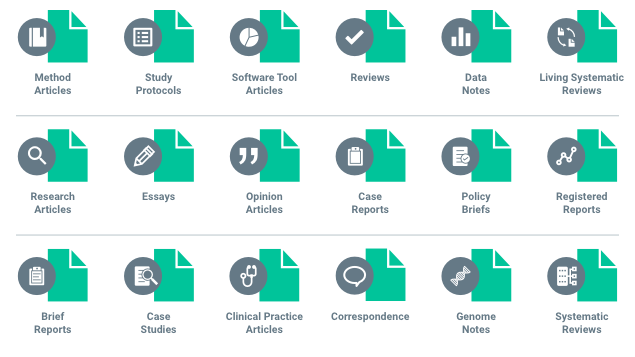Open peer review
Making it easier to trust research by increasing transparency in peer review
What is open peer review?
Open peer review is an open research practice that enables transparency and accountability in the peer review process. Typically, it refers to any peer review model that makes aspects of the peer review process publicly available before or after publication.
An open peer review model may include any or all the following features:
- Open reports: Peer review reports are published for anyone to read.
- Open identities: Author and/or reviewer identities are shared publicly.
- Open interaction: Authors, editors, and reviewers engage in open discussion.
- Open participation: The wider research community are given a forum to comment on the research.
- Preprint open peer review: Manuscripts are shared via preprint servers ahead of any formal peer review procedures.
- Post-publication commenting: Readers and authors can respond to reviewer reports post-publication.
- Decoupled peer review: The peer review process is facilitated by a different organizational entity than the venue of publication.
watch our FREE WEBINAR ON-DEMAND
Understanding peer review and how it works
Fill in the form below to discover the types of peer review, including the open, post-publication peer review model we use at F1000.
Open peer review
What is the purpose of open peer review?
Open peer review aims to tackle various perceived shortcomings of the traditional scholarly peer review process, including wastefulness, poor incentives, and the lack of transparency.
Advocates of open peer review argue that increased transparency in peer review leads to an improved understanding of published research, more constructive reviews, and well-deserved credit for reviewers.
Unlike closed peer review, where the peer review process is hidden behind closed doors, open peer review widens access to the peer review process, particularly if both reviewer reports and names are published alongside the research.
As such, this commitment to enhanced transparency offers members of the research community and beyond greater insight into the peer review process, including the editorial decision-making process and reviewer feedback.
What are the different types of peer review?
Community peer review
The manuscript is fact-checked and published online, where others in the research community can add comments through a forum. Community peer review fosters scientific discussion and collaboration and allows for faster sharing of research findings.
Post-publication peer review
Following the publication of a manuscript, expert reviewers assess the research in an open forum following publication. The names of the reviewers are usually published along with their comments.
Decoupled peer review
The peer review process is managed by an independent service, not the venue of publication. Authors then submit their peer-reviewed work to a publication. Decoupled peer review enables authors to enhance a manuscript before submitting it to a traditional journal.
Benefits of open peer review
Open peer review recognizes the importance of reviewer feedback, the integrity of the review process, and the vital role that it plays in building trust in research.
Challenges of open peer review
Open peer review
Concerns over honest feedback
It’s a common concern among researchers that critical reviewers will suffer career consequences. This is especially troubling for early career researchers that depend on senior researchers for opportunities and advancement. Yet, open peer review presents numerous opportunities for improved peer review practices. By making the peer review process fully open, reviewers are held accountable for their feedback. Any bias or negative behaviors are made more transparent, reducing opportunities to engage in negative behavior.
Open peer review
Misconceptions around rigor
Another concern among researchers is the view that open peer review is less rigorous than closed peer review. However, open peer review reports are often more valuable for researchers when compared to closed peer review reports, perhaps because reviewers know anyone can see their feedback. In fact, due to the increased visibility and transparency, authors often receive a more considered, rigorous review, with constructive suggestions for improvements to increase the quality of their research.
Open peer review
Authors not understanding its value
Researchers can also be hesitant to publish in open peer review publications because they don’t understand its value to authors. Yet, authors gain a lot from open peer review because they can read the full reviewer report and reply to the reviewer with comments when they submit a revision. Open peer review also helps authors to better understand the reviewer’s point of view, which can be challenging in closed models of peer review where reports are not always shared fully with authors.
Open peer review
What can be peer reviewed openly?
Many forms of research can be peer reviewed transparently, including traditional Research Articles.
Here are just some of the article types that can be peer reviewed openly on an F1000 publishing venue.

Becoming a peer reviewer
There’s no single route to becoming a peer reviewer, but if you would like to get involved in peer reviewing, then the below practical steps will help you get started:
Accept invitations for relevant papers or express interest. Some publications may have registration forms you can submit to volunteer as a peer reviewer for their publication. Although, the author may have the final say on who reviews their paper.
Assess the manuscript in good time. If you have been invited to peer review, you will be expected to evaluate a manuscript in a fair, timely, and robust manner. Before you agree, ensure you can perform the review within the time frame and state any conflicts of interest.
Write the peer review report and sign your name. When drafting your peer review report, give yourself enough time to write an organized review that includes constructive and fair feedback, and specific examples where possible. The critique should be useful and help the authors improve their manuscript.
Open peer review
Co-reviewing and open peer review
Efforts to include early career researchers (ECRs) in the peer review process are on the rise. Many funders and other organizations now offer training and resources for ECRs looking to become peer reviewers.
There are many benefits to involving junior researchers in the peer review process, including expanding the pool of well-trained reviewers and encouraging greater diversity in peer review. ECRs are considerably more diverse than senior researchers in terms of gender and ethnicity, so their inclusion can help diversify research. Yet, their involvement in peer review is often overlooked.
However, with open peer review, ECRs receive the recognition they deserve for the work that they do by allowing them to openly share their names and reviewer reports alongside manuscripts that have been published open access.
Open peer review
How common is open peer review?
Open peer review adoption has been growing since the turn of the century, but recently it’s become widely embraced. Many publishers already implement some form of open peer review. Yet, the level of openness often differs in terms of what is revealed to whom and when.
This shift towards open peer review shows no sign of slowing down, with even more publishers looking to incorporate open peer review into their publishing models. In 2018, editors and publishers from over 100 publications signed an open letter to acknowledge that they have started, or plan to start, publishing peer review reports openly.
Expand your open research knowledge

Peer review is not just quality control, it is the backbone of modern scientific and academic publishing, ensuring the validity and credibility of research articles. While it may seem like…

The peer review process is a fundamental component of scholarly publishing, ensuring the quality and credibility of academic research. After submitting your manuscript to a publishing venue, it undergoes rigorous…

Peer review is an integral part of scholarly communication and academic publishing. A key player in this process is the peer reviewer, who is typically a recognized expert in the…
